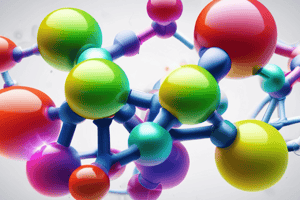Podcast
Questions and Answers
What is the atomic number of carbon?
What is the atomic number of carbon?
- 6 (correct)
- 8
- 12
- 4
What is the electron configuration of carbon?
What is the electron configuration of carbon?
- 1s² 2s² 2p² (correct)
- 1s² 2s² 2p⁴
- 1s² 2s⁴
- 1s⁴ 2s²
How many electrons are in the outermost energy level of a carbon atom?
How many electrons are in the outermost energy level of a carbon atom?
- 8
- 2
- 6
- 4 (correct)
What is the number of valence electrons in a carbon atom?
What is the number of valence electrons in a carbon atom?
What is the percentage of the naturally occurring isotope Carbon-12?
What is the percentage of the naturally occurring isotope Carbon-12?
What does the prefix 'tri-' indicate in the IUPAC name of the Ni(CO)3(NH3)2(NO2)2+ complex?
What does the prefix 'tri-' indicate in the IUPAC name of the Ni(CO)3(NH3)2(NO2)2+ complex?
What does the prefix 'bis-' indicate in the IUPAC name of the Ni(CO)3(NH3)2(NO2)2+ complex?
What does the prefix 'bis-' indicate in the IUPAC name of the Ni(CO)3(NH3)2(NO2)2+ complex?
What does the term 'dinitrito' indicate in the IUPAC name of the Ni(CO)3(NH3)2(NO2)2+ complex?
What does the term 'dinitrito' indicate in the IUPAC name of the Ni(CO)3(NH3)2(NO2)2+ complex?
What is the oxidation state of the nickel ion in the Ni(CO)3(NH3)2(NO2)2+ complex?
What is the oxidation state of the nickel ion in the Ni(CO)3(NH3)2(NO2)2+ complex?
What is the correct IUPAC name for the Ni(CO)3(NH3)2(NO2)2+ complex?
What is the correct IUPAC name for the Ni(CO)3(NH3)2(NO2)2+ complex?
Flashcards are hidden until you start studying
Study Notes
Atomic Structure of Carbon
Atomic Number and Mass
- Atomic number: 6
- Atomic mass: 12.01 u (unified atomic mass units)
Electron Configuration
- Electron configuration: 1s² 2s² 2p²
- Number of electrons in the outermost energy level: 4
Atomic Radius
- Atomic radius: 77 pm (picometers)
- Covalent radius: 77 pm
- Van der Waals radius: 170 pm
Valence Electrons
- Number of valence electrons: 4
- Ability to form bonds: 4 covalent bonds
Isotopes
- Three naturally occurring isotopes:
- Carbon-12 (98.93%)
- Carbon-13 (1.07%)
- Carbon-14 (trace amounts)
- Radioactive isotope: Carbon-14
Atomic Structure of Carbon
Atomic Properties
- Atomic number of carbon is 6, which means it has 6 protons in its atomic nucleus.
- Atomic mass of carbon is 12.01 u, which is a weighted average of the masses of its naturally occurring isotopes.
Electron Arrangement
- The electron configuration of carbon is 1s² 2s² 2p², which means it has two electrons in the first energy level, two electrons in the second energy level, and two electrons in the second subenergy level.
- Carbon has four electrons in its outermost energy level, which determines its chemical properties.
Size and Shape
- The atomic radius of carbon is 77 pm, which is the distance from the nucleus to the outermost electron.
- The covalent radius of carbon is also 77 pm, which is the distance from the nucleus to the outermost electron in a covalent bond.
- The van der Waals radius of carbon is 170 pm, which is the distance between the nuclei of two carbon atoms that are not bonded to each other.
Bonding Properties
- Carbon has four valence electrons, which means it can form four covalent bonds with other atoms.
- Carbon's ability to form four covalent bonds allows it to form a wide variety of compounds.
Isotopes of Carbon
- Carbon has three naturally occurring isotopes: Carbon-12 (98.93%), Carbon-13 (1.07%), and Carbon-14 (trace amounts).
- Carbon-14 is a radioactive isotope of carbon, which means it decays over time and is not stable.
Ni(CO)3(NH3)2(NO2)2+ Complex
IUPAC Nomenclature
- The IUPAC name for the Ni(CO)3(NH3)2(NO2)2+ complex is Tri-carbonyl-bis-ammine-dinitrito-nickel(II) ion.
- The "Tri-carbonyl" prefix indicates the presence of three CO ligands.
- The "Bis-ammine" prefix indicates the presence of two NH3 ligands.
- The "Dinitrito" prefix indicates the presence of two NO2 ligands.
- The "Nickel(II) ion" part of the name indicates that the central metal ion has a +2 charge.
Studying That Suits You
Use AI to generate personalized quizzes and flashcards to suit your learning preferences.




